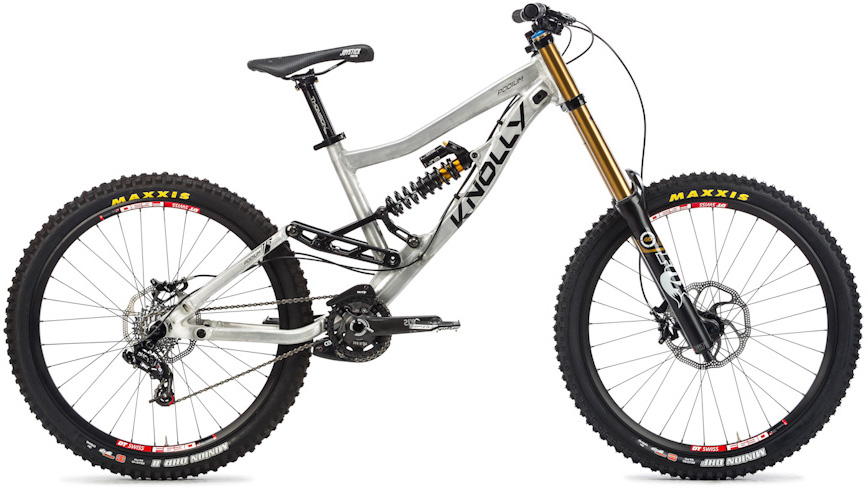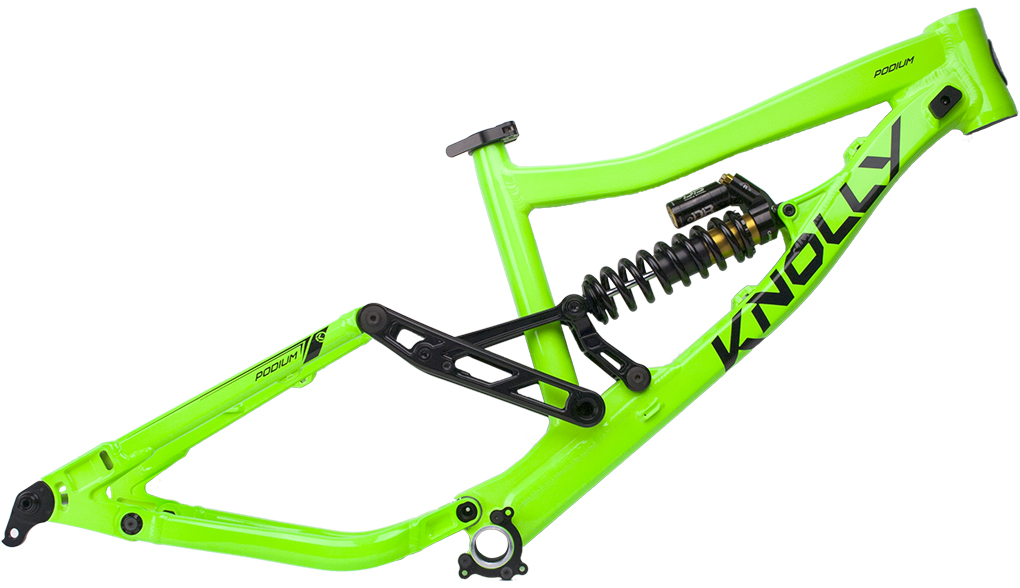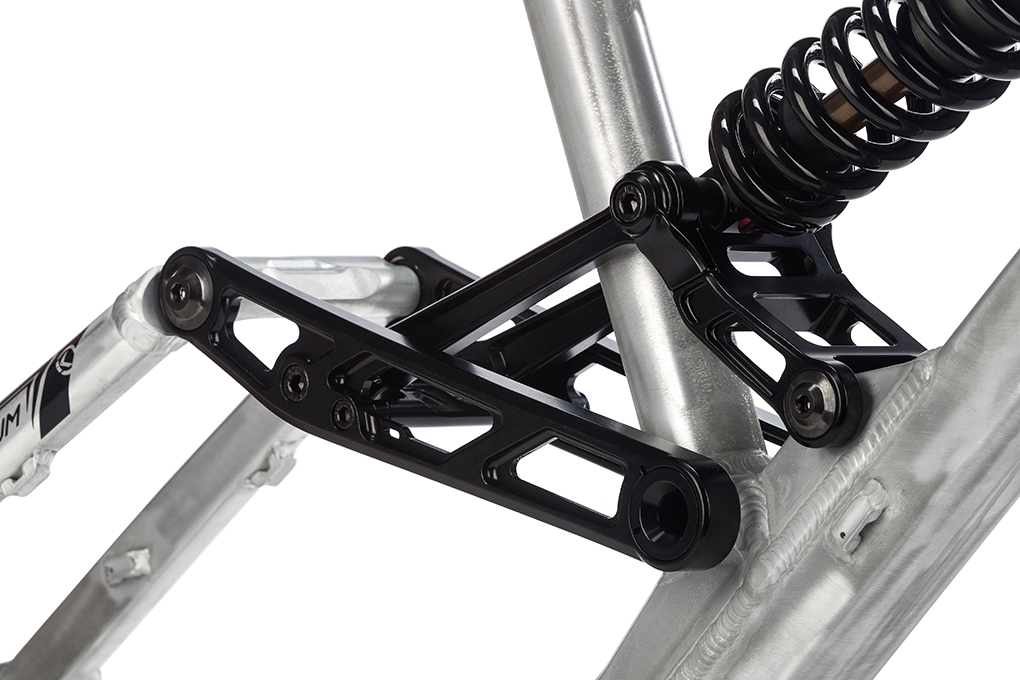
Bike: 2014 Knolly Podium
Size Tested: Medium
Frame Weight (w/ Cane Creek Double Barrel Air Shock): 9.51 lbs
Bike Weight (as tested w/out pedals): 36.94 lbs
Geometry: (see page 3)
Reviewer Info: 5’ 8” 160 lbs
Build: (see section below)
MSRP (as tested): $6026
Days Tested: 6
Test Location: Whistler, BC
Based in Vancouver, British Columbia, Knolly Bikes has a reputation for making fun, durable bikes that handle steep, rugged trails really well. They’ve never been primarily interested in building frames with the lowest weight in class or advertising geometry numbers that follow whatever the latest trend might be.
We were curious to see if Knolly lived up to their reputation, so the Podium, a downhill bike built to tackle bike parks, gravity trails, and rough terrain, was high on out list in for our test trip to Whistler, BC.
The Build
We tested a Day Glo Green Podium set up with Knolly’s base model build kit: a full Shimano Zee group, a Race Face cockpit, Spank wheels, Maxxis Minion tires, and a SR Suntour RUX fork. Knolly’s flagship version of the Podium is built up with a Shimano Saint drivetrain and brakes, Race Face SixC cranks, Chromag cockpit parts, lighter Spank wheels, and a Fox 40 air fork.
Either Podium model can be equipped with a Fox RC4, Cane Creek Double Barrel Coil, or Cane Creek DBA CS shock.
Frame Specs & Geometry
The specs of the Podium’s frame are pretty standard for a modern downhill bike. The headtube is a straight 1.5” affair that allows riders to run angle reducing or increasing headsets if they like. The bottom bracket is a standard 83mm shell with an ISCG05 mount wrapped around it, and the rear end is the new 157mm x 12mm standard, allowing up to a 3” wide tire.
The frame’s cable routing is clean and external. Integrated headset bumpers keep the dual crown fork from damaging the frame. Most of the frame’s tubeset features some degree of hydroforming while the suspension linkage is a strictly machined piece. Clean looking, custom titanium fasteners and dust covers adorn all of the pivots, and single tube is smoothly bent into a U to create the chainstays, reducing nooks and crannies where dirt might collect.

In terms of geometry, the Podium is pretty standard. The frame’s bottom bracket height isn’t low, at 13.94”, nor is it especially high. The head tube angle is moderate for a downhill bike at, 63.5 degrees, and the chainstay length is pretty average at 17.28”. The wheelbase is 46.81” for the Medium frame, and the 16.02” reach follows conventional downhill bike sizing (despite the new “longer-is-better” mentality that seems to be driving the design on some bikes these days).
*A quick side note while we’re talking about the Podium’s frame: Knolly has a drawing on their website that provides recommended torque specs for all of the frame’s fasteners. This is useful info that often very difficult to find. Thanks, Knolly.
The Ride
Handling & Sizing
Right off the bat, I felt comfortable on the Podium. The handling is relatively neutral, as the frame’s geometry suggested it would be. Through tight sections the bike felt just right; both nimble and composed. At higher speeds the bike did start to feel just a little short, but I only rarely felt like I might want to try a larger size. That said, if you do prefer bikes with longer wheelbases, I’d recommend getting on the Podium in both your normal size and a larger frame size for a test ride before you buy.
Rear Suspension Performance
Knolly’s 4xFour suspension linkage has a unique look, wrapping around the seat tube which leans back, out from the down tube instead of emerging from the bottom bracket. The system might be looked at as a variant of Horst Link four bar suspension in that it features a pivot located on the chainstay below of and in front of the axle. However, it Knolly’s 4xFour adds a second, four-bar linkage to drive the shock. This allows the leverage rate to be tuned separately from the wheel path and the use of a full length seat tube.

The design of the Podium’s rear suspension is very active and yields great traction and good sensitivity, though at the expense of some pedaling efficiency. The primary advantage of a Horst Link four-bar suspension, though, is that grabbing a handful of your brake lever doesn’t inhibit rear suspension motion. This is most noticeable when braking through rough terrain, as the Podium feels smoother than a single pivot design, or one with a pivot on the seatstay.
With that said, while the bike didn’t tend to hang up on square edge hits, it didn’t make them disappear, either. It absorbed chatter reasonably well and handled large impacts with composure, but was second in this regard the Specialized S-Works Demo 8, which carried speed through the rough better than any bike we tested in Whistler. In steep technical situations, the Podium’s rear suspension did a reasonable job of providing braking traction when there wasn’t much available, smoothly handling g-outs using most of the travel, but didn’t bottom out harshly or flex laterally/squirm.
The bike felt very predictable and stayed in the middle of the travel through high-speed berms, though Noah Bodman and I both thought the Podium didn’t feel quite as grippy in these situations as the S-Works Demo with the ÖhlinsTTX22M shock.
Of course, the fact that the Podium and Demo run two different shocks makes it hard to say for sure how much of this difference in performance was due to their different suspension geometries. But, for what it’s worth, the Podium’s longer chainstays seemed to make it easier to get the fore-aft weight balance correct when transitioning out of steep pitches. So given the opportunity to try an ÖhlinsTTX22M (or some very similar shock) on the Knolly, I wouldn’t be surprised to find it come out ahead of the S-Works Demo through a berm.
